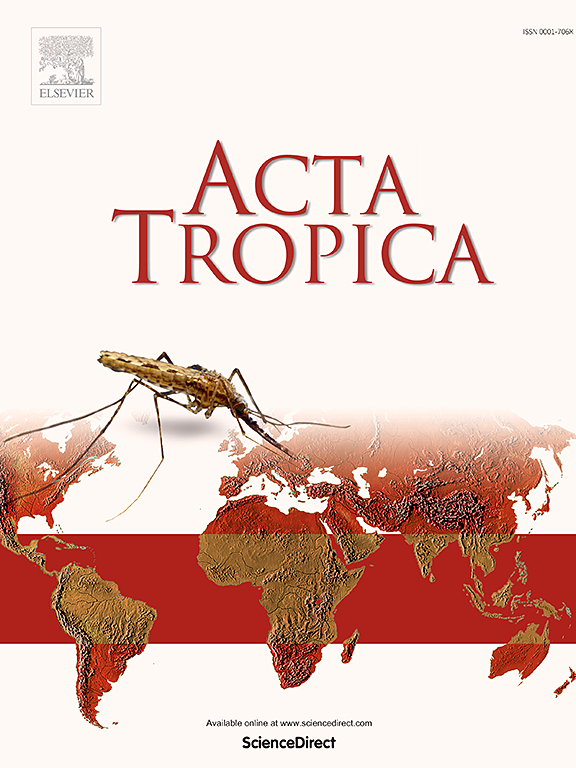Viral metagenomics of hematophagous insects collected in the Carajas mining complex, Pará State, Brazil
IF 2.1
3区 医学
Q2 PARASITOLOGY
引用次数: 0
Abstract
Hematophagous insects are vectors of viruses that cause diseases in humans and animals worldwide. Mosquitoes (Culicidae), biting midges (Ceratopogonidae), and sandflies (Psychodidae) were collected in three municipalities (Marabá, Canaã dos Carajás, and Curionópolis) in the state of Pará, Brazil, in 2019. Morphological keys were used for the taxonomic identification of insect species. High-throughput sequencing and metagenomic analysis were employed to characterize the viromes of the hematophagous insects. We characterized the virome of 839 insects grouped into 14 pools. A total of 729 million paired reads were generated, with 12 million viral sequences (3 % of the reads). The families Reoviridae, Myoviridae, Retroviridae, and Poxviridae were found in all samples of this study. Phylogenies of RNA-dependent RNA polymerase (RdRp) from viruses of the families Chuviridae, Dicistroviridae, Flaviviridae, Iflaviridae, Mesoniviridae, Phenuiviridae, and Rhabdoviridae were performed. In this study, the first isolation of the Guaico Culex Virus (GCXV) in the northern region of Brazil was obtained from a pool of Culex (Melanoconion) spp. mosquitoes collected in Curionópolis. The data obtained in this study demonstrate that the Carajás region has an ecosystem rich in viruses. Additional studies are needed to understand the dynamics of viruses in vectors, vertebrates, and the human population in the region.
在巴西par州Carajas矿区采集的食血昆虫的病毒宏基因组学。
食血昆虫是在世界范围内引起人类和动物疾病的病毒载体。2019年在巴西帕尔州3个市(马拉布、Canaã多斯Carajás和Curionópolis)采集蚊虫(库蚊科)、蠓科(蠓科)和白蛉(蠓科)。形态学关键字用于昆虫种类的分类鉴定。采用高通量测序和宏基因组分析对吸血昆虫的病毒组进行了鉴定。我们将839只昆虫分为14个群体,对它们的病毒组进行了鉴定。总共产生了7.29亿对读取,其中有1200万对病毒序列(占读取量的3%)。在本研究的所有样本中均发现呼肠孤病毒科、肌病毒科、逆转录病毒科和痘病毒科。对鸡冠病毒科、蝶状病毒科、黄病毒科、黄病毒科、中鼻窦炎病毒科、phenuivirus科和Rhabdoviridae病毒的RNA依赖性RNA聚合酶(RdRp)进行了系统发育分析。本研究从Curionópolis采集的库蚊(Melanoconion)种蚊池中获得巴西北部地区首次分离到瓜伊科库蚊病毒(GCXV)。本研究获得的数据表明Carajás地区具有丰富的病毒生态系统。需要进一步的研究来了解病毒在该地区的媒介、脊椎动物和人群中的动态。
本文章由计算机程序翻译,如有差异,请以英文原文为准。
求助全文
约1分钟内获得全文
求助全文
来源期刊

Acta tropica
医学-寄生虫学
CiteScore
5.40
自引率
11.10%
发文量
383
审稿时长
37 days
期刊介绍:
Acta Tropica, is an international journal on infectious diseases that covers public health sciences and biomedical research with particular emphasis on topics relevant to human and animal health in the tropics and the subtropics.
 求助内容:
求助内容: 应助结果提醒方式:
应助结果提醒方式:


